'Swatow',· or 'Swatow ware', 'Shantouqi'· in Chinese, is the name given to a certain kind of porcelain. Why the name Swatow is used is still uncertain. It is possible that the porcelain was first seen in Shantou,· Guangdong,· from which it derived its name, and this name has continued in use until today. The name probably first appeared around the second half of the sixteenth century and beginning of the seventeenth century when this type of porcelain was first exported.
The foremost book on 'Swatow ware' is Barbara Harrison's Swatow in Het Princessehof. 1 This notes that, in general, besides the plain "white" glazes, 'Swatow ware' includes varieties of "blue-and-white", "celadon", "coloured glaze" and "polychrome overglazed decoration". It also mentions that it comes in a number of different forms, such as large dishes, plates, bowls, vases and small jars. Its main characteristics are the following:
1. A plain "white" glaze which is comparatively rough, thick and presents a prevailing greyish tint.
2. A "blue-and-white" glazed pattern, which commonly features a tint of greyish blue, blue with occasional black specks, or dark green.
3. A "celadon" glaze which is usually of a greyish tint (possibly caused by an underlying white body colour), often with fissures due to excessive glaze on the lower sections and a mostly uneven glaze on the bottom;
4. "Coloured" glazes in blue, brown or green with frequent white body underglaze.
5. A "polychrome overglazed decoration" with a prevailing red colour, although a green, black or brown overglazed background colour is also common with a tendency for colour pigments to flake off easily.
Also:
1. A "blue-and-white" glazed pattern resembling the contemporary official court and Imperial porcelain fired at Jingdezhen,· exhibiting the less refined manufacture and inferior decoration common to secondary kiln production. Brushstrokes of the varied patterns cover a wide range of styles, from the free flowing to the extremely delicate;
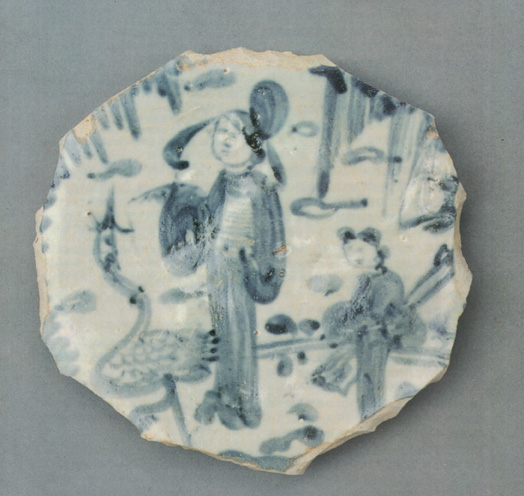 Central section of 'Zhangyao ware' plate with underglaze celadon painting of a classical lady and attendant with a crane.
The National Museum Collection, Tokyo, Japan.
Central section of 'Zhangyao ware' plate with underglaze celadon painting of a classical lady and attendant with a crane.
The National Museum Collection, Tokyo, Japan.
2. The usual appearance on the foot-rims of deposits of sand, used to separate items while in the kilns.
The patterns on "blue-and-white" and "polychrome overglazed decoration" are usually set in a white reserve within a colour background, and include floral, bird or landscape motifs. In general, the main pattern is painted on the inner surface or on the major projecting areas. Floral patterns usually consist of peonies, lotus flowers, orchids, pines and bamboo, while bird motifs usually consist of phoenixes, pheasants, eagles, egrets, cranes, geese, magpies and wild ducks. Landscape compositions commonly include mountain-and-seascapes, oceanic fairylands and mythological autumn rivers. Other themes include: sacred animals, display dragons, keilun·, lions, bats and deer; ideogram representations, displaying 'fu '· ('fortune') and 'shou'· ('longevity'); and 'compasses', ships and ichthyosaurs. Less common are portraits and depictions of seals.
Patterns on monochrome overglaze are usually moulded into the body in the shape of flowers, fish or ideograms. More rare are white patterns on a blue or brown background glaze.
At present, no 'Swatow ware' exists anywhere in mainland China, even at archaeological sites. It is sparsely represented in private and public collections, both in terms of quantity and variety. This may be down to the fact that it was exported in great quantity in the past and was not particularly highly valued in its country of origin. By tracing its export history, therefore, we can identify certain information.
In Japan, for instance, 'Swatow ware' has been found at the sites of a number of historical ruins and archaeological sites dating back to the late sixteenth and early seventeenth centuries, in the areas of Aomori, Kansai, Osaka, Sakai and Tokyo. Much of it is presently found in the collections of national museums and public galleries. In Japanese academic terminology, it is called 'South China porcelain'· or 'Guangdong and Fujian Province porcelain'.· Some items are simply labelled "of unknown origin". Examples with "polychrome overglazed decoration" are commonly called 'wuzhou chihui'· ('red-painted china from Wuzhou'), while the 'colour' mono chromes are called 'mochibanatei'.·
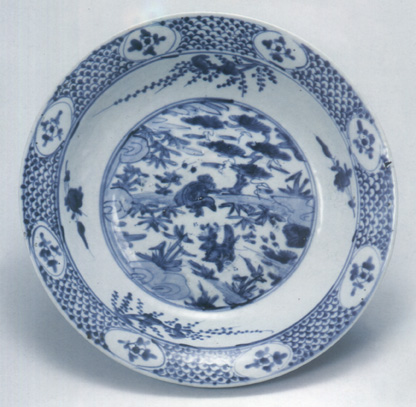 A large 'Zhangyao ware' plate with a central reserve and two peripheral ornamental bands, with underglaze 'blue-and-white' painting of a bird and phytological motifs.
The National Museum Collection, Tokyo, Japan.
A large 'Zhangyao ware' plate with a central reserve and two peripheral ornamental bands, with underglaze 'blue-and-white' painting of a bird and phytological motifs.
The National Museum Collection, Tokyo, Japan.
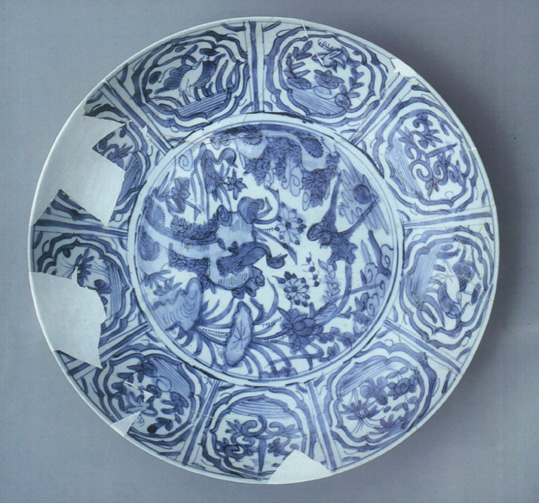 A 'Zhangyao ware' plate with a central reserve and nine peripheral medalions, with underglaze 'blue-and-white' painting of 'bird-and-flower' motifs.
A 'Zhangyao ware' plate with a central reserve and nine peripheral medalions, with underglaze 'blue-and-white' painting of 'bird-and-flower' motifs.
In Southeast Asia, besides Indonesia— where it has been found in great numbers —, 'Swatow ware' has been discovered at historical sites in Malaysia, the Philippines, Singapore, Thailand and Vietnam. Recognised as part of the cultural heritage of these countries, it has been eagerly collected by local museums. The Singaporean scholar Han Huaizhun,· who was formerly of the Zhongguo Zhongyang Wenshiguan· (Central Museum of Culture and History of China) and who presently advises on Chinese porcelain for the Gugong Buwuguan· (Museum of the Forbidden City)), has researched 'Swatow ware' for a considerable number of years. He noted: "[...] porcelain exported by sea to Southern Asia was mostly tricolour and blue-and-white with sandy residues at the base, and produced in Southern China. [...] This type of porcelain is often called 'Swatow ware' by foreign collectors."2
When the Witte Leeuw, a merchant ship which sank in 1613, was salvaged in the Eighties, it was found to be carrying 'Swatow ware', as was the San Diego, a cargo vessel which sank in 1600, when salvage work first started in 1992. As both ships belonged to the [Dutch] East India Company {sic}, this china was almost certainly destined for the European market. It has also been determined that a number of items of ceramic ware unearthed at the ruins of [?]** in Egypt originated from Swatow, 3 and that they are the same in type and quality to porcelain also found in East Africa. 4
It is perhaps because 'Swatow ware' has been found both in the Far East and in the West during the last few decades that scholars and collectors worldwide have been increasingly focussing their efforts on determining its exact point of origin, traditionally said to be the coastal regions of the provinces of Guangdong· and Fujian.· No evidence confirming the exact manufacturing sites of 'Swatow ware' and the location of its firing kilns existed prior to the early Nineties. However, recent archaeological research in Fujian province has conclusively proved that a number of factories dating back to the Ming· (1368-1644) and Qing dynasties, scattered over a considerable area around the city of Zhangzhou, were the major centres of production.
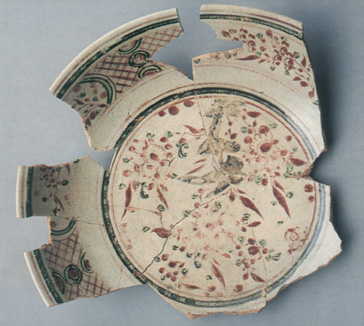 A partially reconstructed 'Zhangyao ware' deep plate with a central reserve and decorated border, with underglaze sancai ('three-colour').
A partially reconstructed 'Zhangyao ware' deep plate with a central reserve and decorated border, with underglaze sancai ('three-colour').
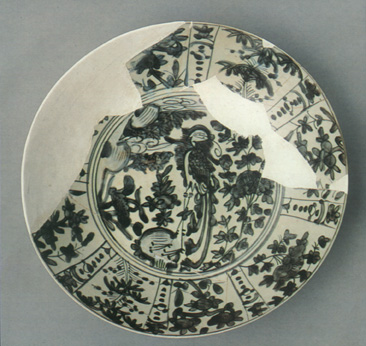 A partially reconstructed 'Zhangyao ware' plate with a central reserve and segmental border, with underglaze 'blue-an-white' painting of a bird and phytological motifs.
A partially reconstructed 'Zhangyao ware' plate with a central reserve and segmental border, with underglaze 'blue-an-white' painting of a bird and phytological motifs.
Zhangzhou, situated in the south of Fujian province, adjacent to the Chaoshan region and to the west of Guangdong province, directly faces the Taiwan Strait (or Formosa Strait). The Jiulongjiang· River, the second largest in Fujian province, provides this area with a good network of water connections and allows considerably-sized vessels to navigate directly to Yuegang, · on the South China Sea coast. Great seaports stand at the mouths of the region's other rivers, the Zhangjiang,· Luxi· and Dongxi,· enhancing their historical potential as hubs for overseas maritime trade. This fact was fully exploited during the Ming dynasty, in the aftermath of the removal of the traditional prohibition on sea trade and the opening of Yuegang to foreign maritime commerce. During this era, the fortunes of Yuegang as a prime international maritime trading centre in southern China rose rapidly, only to decline again in the early Qing dynasty when trade prohibition laws were once again enforced by the Empire's central government.
This considerable increase in trade, which greatly enriched the region during the Ming dynasty, was one of the major reasons for the development of the local earthenware industries. Large quantities of ceramics and porcelain, alongside other products native to the province, such as raw silk and tea, were loaded onto local and foreign ships sailing to Taiwan, the Philippines and beyond, to Southeast Asia, Korea and Japan. Today, all that is left of the Ming era Swatow ware kilns are fifty or so ruins.
The study of ruined kilns in the Zhangzhou area started in the Fifties, with the original goal of finding the former kilns of a particular kind of off-white glazed porcelain traditionally called 'Zhangyao' ('Zhangyao ware'). This culminated in the early Eighties with the discovery of the so-called 'Dongxi yaochi'('Dongxi kiln'), situated in the lower Dongxi· River region, in Hua'an· county. During these years of archaeological research, not a single item of 'Swatow ware' was found.
It was not until the mid-Eighties, following the discovery of a scattered series of ruined kilns for the production of unknown 'blue-and-white' porcelain around Pinghe,· Zhangpu,· Nanjing,· Hua'an,· Shao'an· and Yunxiao· in the Zhangzhou region, that a theory on the original production site of 'Swatow ware' was first mooted.
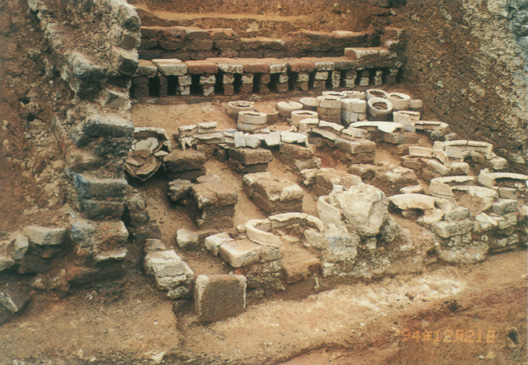
Archeological site of Dalong yao, 大垄址, near Wuzhai 五寨 village, in Pinghe 平和 county, Zhangzhou 漳州 district, in Fujian 福建 province, where examples of 'Zhangyao' 漳窟 ('Zhangyao ware') were unearthed.
It was only in the early Nineties, however, with the progress of excavation work on the unravelling of the origins of the history of ceramics and porcelain in the area, that a conclusive relationship between the recently discovered kilns and the production of' Swatow ware' was finally accepted. This coincided with the visit of Ken Morimura, the leading Japanese authority on Chinese porcelain, who brought the importance of the findings out into the open. Due to China's open-door policy and the broadening of academic contacts with cultural institutions abroad, research on 'Swatow ware' has accelerated. Recently, through case studies and further excavations at the ruined kiln site of Pinghe organized by the Fujian Sheng Buwoguan· (Fujian Provincial Museum) with assistance from the Kaogu Zhuanye·(Archeology Department) of Nanjing Daxue· (Nanjing University) and the Riben Jinshi Kaguxui Yanjiuhui· (Institute of Modern Age Archeology Studies), considerable breakthroughs have been made. The preliminary studies of the last two decades have enabled the creation of a classified survey, based mainly on technical aspects and stylistic production typologies, of the so-called 'Zhangzhou yaochi' ('Zhangzhou kilns') the chief production centre of 'Swatow ware' during the Ming and Qing dynasties. The preliminary results of this vast body of research were published last year under the title of Zhangzhou yao· (Zhangzhou Kilns). 5
It is interesting to note that most of the early earthenware, ceramics and porcelains produced at the 'Zhangzhou kilns' exhibit the characteristics of 'Swatow ware' listed at the beginning of this short paper. Furthermore, considering the historical background, the exceptional geographic location of Zhangzhou and the region's massive export trade during the Ming and the Qing dynasties, we can now be certain that the types of china produced in the Zhangzhou area are examples of 'Swatow ware'. Sites of secondary kilns of the same era that also produced these kinds of porcelain have been traced to Xiamen,· Yuedong· (East Guangdong), Dapu,· and Xianggang· (Hong Kong), yet the Zhangzhou area remains by far the most important production centre so far discovered, not only in terms of the number and size of the factories, but also as regards production techniques, shapes, styles and quantities.
The diversity of output of the 'Zhangzhou kilns', of significant importance both for the study of the history of Chinese porcelain and the history of the ceramic and porcelain trades globally, stretched to far more then just 'Swatow ware'. Studies on this subject are currently being undertaken at a rapid pace. It is anticipated that there will be a wide exchange of information between Eastern and Western scholars and researchers which should almost certainly bring to light increasingly specific information.
Translated from the Chinese by: 谢永平 Che Weng Peng
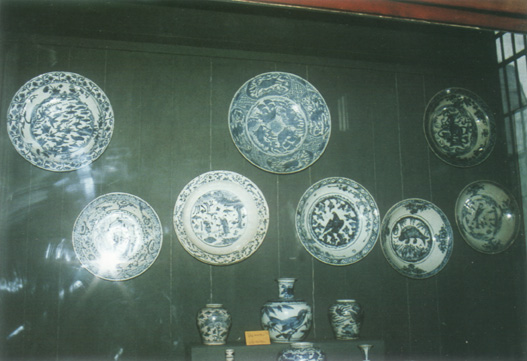
Examples of 'Zhangyao ware' plates and vases, with underglaze 'blue-and-white' painting.
The National Museum Collection, Jakarta, Indonesia.
NOTES
"及福斯塔特" (or should it be "福斯塔特") in the original Chinese text refers to the name of an unidentified historical site in Egypt. The pinyin is "Ji fu si ta te" ("fu si ta te ") or, in Guangdonese "Cub fok si tap tak" ("fok si tap tak").
1 HARRISON, Barbara, Swatow in Het Princessehof, Leeuwarpen, Gemeentelijk Museum Het Princessehof Leeuwarpen, 1979.
2 HAN Kuaizhun 韩槐准, Tan woguo Ming Qing shidai de waixiao ciqi 《谈我国明清时代的外销瓷器》 (On Exported Chinese Porcelain in the Ming and Qing Dynasties), in "Wenwu" "文物" "Cultural Relics", (9)1965.
3 [Unknown Author], Trading of Porcelain between the East and the West, Izumitsu Museum, (Japan).
4 [Unknown Author], Zhongguo guci zai Feizhou de faxian 《中国古瓷在非洲的发现》 (The Discovery of Chinese Porcelain in Africa), Beijing 北京, Zijincheng Chubanshe 紫禁城出版社 Forbidden City Press, 1987.
5 [Unknown Author], Zhangzhou yao 《漳州窖》 (Zhangzhou Kilns), Fujian Renmin Chubanshe 福建人民出版社 People's Publisher of Fujian Province, 1997.
* Archeologist. Appraisal expert of the Fujian Sheng Bowuguan· (Fujian Provincial Museum).
**Translator's note:
start p. 275
end p.